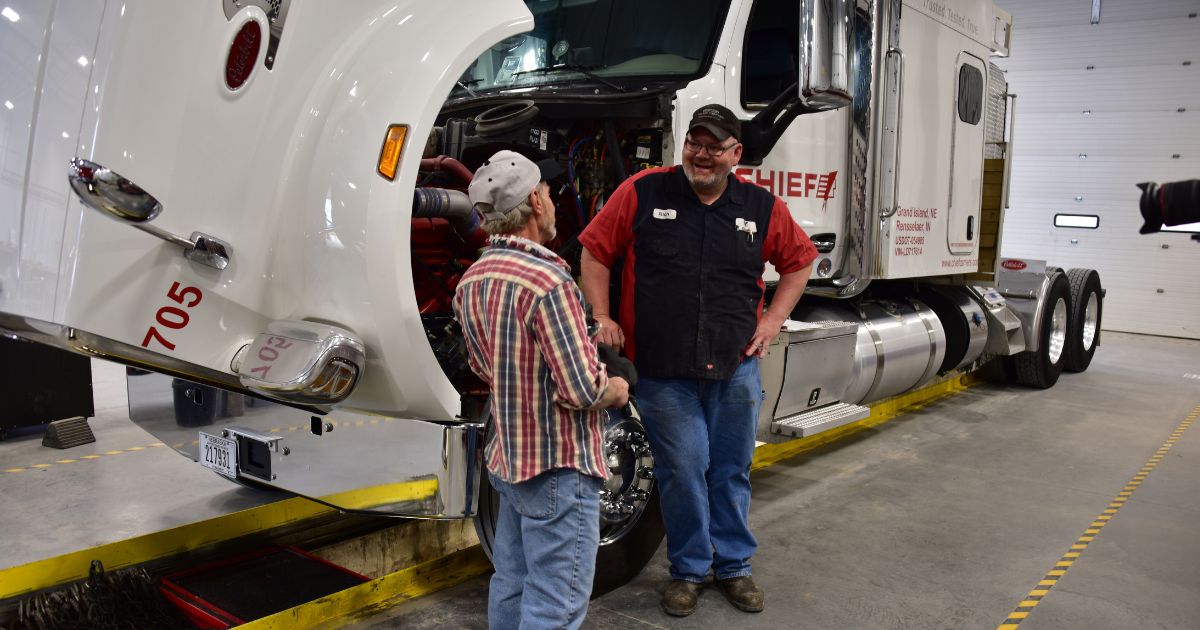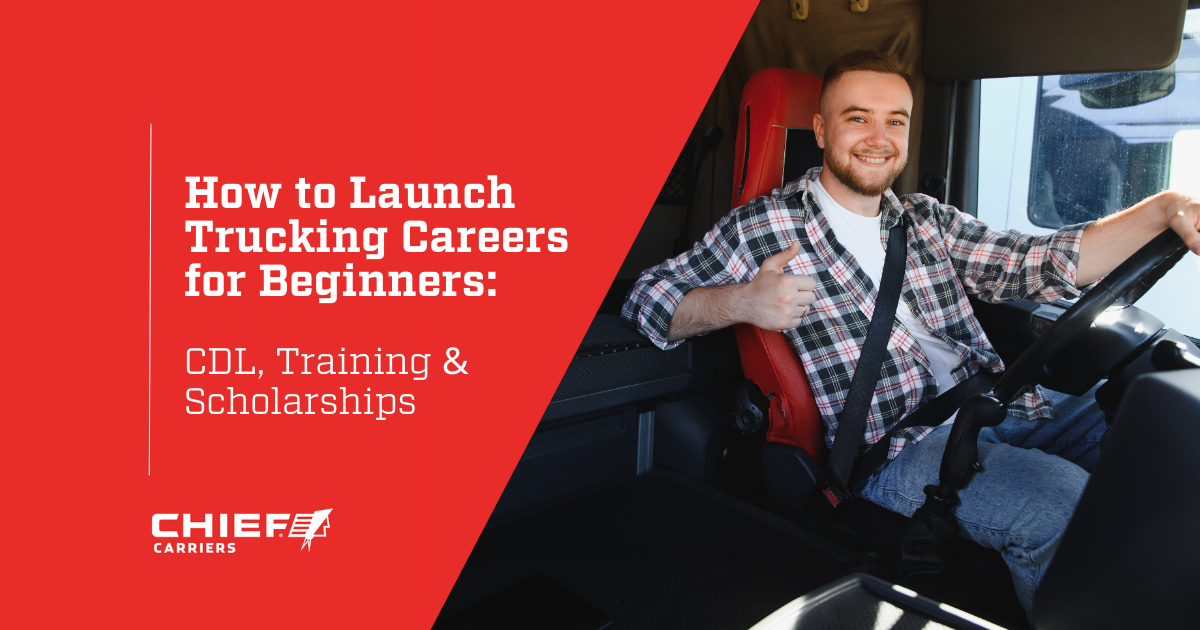How Trucking Associations Offer a Roadmap to a Trucking Career
The demand for skilled professionals in the transportation industry is at an all-time high, offering immediate, stable, and high-paying trucking careers for beginners who are willing to train. The journey to becoming a professional CDL-A driver or certified diesel technician involves completing necessary, federally mandated training and leveraging accessible financial aid, including CDL scholarships, to minimize out-of-pocket costs.
As a leader in flatbed trucking, Chief Carriers understands the critical need for nationwide trucking workforce development. We’ll explain the structure of these paths, outline the steps to become a truck driver or technician, and discuss resources for financial aid that provide early-career support for those new to the trucking industry.

How Trucking Associations Offer a Roadmap to a Trucking Career
The demand for skilled professionals in the transportation industry is at an all-time high, offering immediate, stable, and high-paying trucking careers for beginners who are willing to train. The journey to becoming a professional CDL-A driver or certified diesel technician involves completing necessary, federally mandated training and leveraging accessible financial aid, including CDL scholarships, to minimize out-of-pocket costs.
As a leader in flatbed trucking, Chief Carriers understands the critical need for nationwide trucking workforce development. We’ll explain the structure of these paths, outline the steps to become a truck driver or technician, and discuss resources for financial aid that provide early-career support for those new to the trucking industry.

From Zero to Professional: The Step-by-Step CDL Pathway
Starting your career as a professional driver requires compliance with federal safety and training standards, such as entry-level driver training and CDL licensing, designed to produce safe, capable drivers.
The ELDT Mandate Explained
Entry-Level Driver Training (ELDT) is the federally required minimum standard for new CDL applicants seeking a Class A or Class B license. This mandate ensures that all new drivers receive comprehensive, standardized training before taking the required skills test.
ELDT covers both theoretical (classroom) instruction on topics like hours-of-service, safe operating procedures, and advanced techniques, as well as behind-the-wheel (range and road) instruction. Completing an approved ELDT course is non-negotiable for obtaining a CDL today, as it ensures a baseline of competency and safety for all new trucking professionals.
How to Become a Truck Driver: 5 Steps to Your CDL-A License
The process of earning a CDL and becoming a commercial truck driver is straightforward and focused on structured learning and testing.
- Meet Minimum Requirements: You must be at least 18 (intrastate) or 21 (interstate) years old, possess a valid state driver’s license, and pass a Department of Transportation (DOT) physical examination to obtain a medical card.
- Obtain a Commercial Learner’s Permit (CLP): Pass the required written knowledge tests for the CDL class and endorsements you seek.
- Complete an Approved CDL Training Program (ELDT): Enroll in a certified school that meets all federal ELDT requirements. This is where you gain the critical skills needed for real-world driving.
- Pass the Written and Skills/Road Tests: Successfully complete the three-part skills test (pre-trip inspection, basic vehicle control, and road driving) administered by a certified third party or state examiner.
- Secure Your First Job: Begin applying for beginner truck driving jobs. Top carriers often recruit directly from training programs.
Comparison: Simulator vs. On-the-Road Training
Modern truck driver education programs integrate cutting-edge technology to enhance safety and skill development for beginners in the trucking industry. High-fidelity truck-driving simulator technology allows trainees to practice complex, high-risk scenarios—such as unexpected blowouts, evasive maneuvers, and driving in extreme weather—in a controlled, risk-free environment. This is a critical advantage, as it builds essential muscle memory and quick decision-making skills without vehicle wear-and-tear or safety concerns.
Traditional on-the-road training remains essential for gaining real-world experience, navigating diverse traffic conditions, and mastering essential tasks like pre-trip inspections and live coupling. The most effective programs combine the benefits of both methods.
The table below compares simulators vs. on-the-road training methods.

High-Demand Maintenance: Launching a Diesel Technician Career
Not all high-value jobs in the trucking industry are behind the wheel. The integrity of the supply chain depends equally on highly skilled maintenance professionals to keep the trucks on the road.
Why the Technician Role is Critical
There’s a massive demand for skilled diesel technicians across the logistics sector, making the diesel technician career path a critical component of trucking workforce development. Without technicians to maintain complex, modern equipment, fleets cannot run safely or efficiently. This technical career offers significant stability, high pay, and opportunities to advance into management or specialized roles.
At Chief Carriers, we finally stopped crossing our fingers for “unicorn” diesel techs and started growing them ourselves. Our in-house program lets someone who’s mechanically inclined earn a paycheck while we train them on modern engines, diagnostics, and safety without taking on school debt. It helps us keep trucks on the road, and it gives those techs a long-term, high-demand career instead of just another job.
-Andrew Winkler, General Manager of Chief Carriers

How to Become a Certified Diesel Technician
Aspiring technicians typically enroll in focused diesel technician training programs at technical colleges or participate in OEM (Original Equipment Manufacturer) apprenticeships.
- Associate’s Degree Programs: Many successful technicians hold a two-year Associate of Applied Science (AAS) in Diesel Technology.
- ASE Certification: The most recognized industry standard is the National Institute for Automotive Service Excellence (ASE) certification. Look for programs that prepare you for certifications like Diesel Engines (T2) and Brakes (T4).
- OEM-Specific Training: Specialized training directly from manufacturers like Cummins, Detroit Diesel, or CAT is highly valuable for focused career paths.
- Company-Sponsored or In-House Training: Many US trucking and fleet maintenance companies offer extensive training programs designed to develop skilled mechanics for their fleets.
RELATED: Repairs and Maintenance: Keeping Truck Fleets on the Road

Structured Data Comparison: Driver vs. Technician Pathways
Comparing these two primary transportation careers helps beginners align their skills and interests with the right pathway.

Eliminating Financial Barriers: CDL Scholarships, Financial Aid, and Paid Training Options
The cost of training should not be a roadblock to a stable, high-paying trucking career for beginning drivers. While they aren’t as numerous as for traditional educational pursuits, resources do exist to help reduce or eliminate tuition costs for commercial truck driver training.
National and State-Specific CDL Financial Aid
Several established programs are available to support individuals pursuing a CDL training program:
- WIOA Grants: Workforce Innovation and Opportunity Act (WIOA) grants are state-level federal funds often used to pay for vocational training, including CDL school.
- Pell Grants: Federal Pell Grants can often be applied to tuition costs at community or technical colleges offering truck driver education programs.
- Veteran Benefits: The Post-9/11 GI Bill and other veteran education benefits are often applicable to CDL schools and diesel technician training programs.
RELATED: The Chief Carriers Veterans Program: How to Use Your GI Bill to Launch a Trucking Career
The Nebraska Advantage: State and Association Resources
The state of Nebraska provides extensive support for new drivers through its trucking association and specialized local Nebraska truck driving programs, creating a unique path for those beginning their careers in the Midwest.
The Nebraska Trucking Association plays a key role in trucking workforce development, often working with local carriers and state agencies to offer grants or connect students with funding opportunities. They help beginner truck drivers by advocating for, and sometimes directly administering, training assistance.
In 2024, we gave away 103 scholarships for diesel tech, and logistics and supply chain management programs in the state. And then we connect through different career fairs and through events throughout the state. We try to connect as many of our member companies that have openings—that need to keep filling their workforce—with people.
-Kent Grisham, President of Nebraska Trucking Association
To find grants for transportation logistics jobs in your area, research state-level initiatives focused on vocational training.
Company-Sponsored Training
This model is ideal for beginners who want to minimize upfront costs and start earning money immediately. In a company-sponsored training scenario, the company covers tuition costs directly.
CDL-A Driver Training
The trucking company uses its own in-house training school or partners with an external provider and pays the tuition directly (or provides a forgivable loan). The student becomes an employee from day one and typically receives a small wage or daily/weekly stipend during the actual training phase to help cover immediate living expenses.
In exchange for the paid training, the driver agrees to work for the company for a set work commitment period, typically 12 to 24 months. If the driver leaves early, they must repay a prorated portion of the tuition cost.
After receiving the CDL, the driver enters a crucial paid over-the-road (OTR) apprenticeship phase with a certified trainer before going solo.
Diesel Technician Training
Companies hire aspiring technicians directly into structured training roles to develop mechanics specifically for their fleets. The main benefit is earning a wage while you learn, eliminating tuition debt.
There are two main types of company-sponsored diesel technician programs:
- Registered Apprenticeship Programs: Formal, structured training tracks registered with the U.S. Department of Labor (DOL) that combine on-the-job training (OJT) with related classroom instruction. These often last 1 to 4 years.
- In-House Training Academies: Short, intensive, proprietary schools (e.g., 6 weeks) run by trucking companies.
The benefits of these programs include employer-paid training costs and the near guarantee of a full-time job upon successful completion. Many companies also provide a valuable starter tool kit or tool allowance upon graduation.

Tuition Reimbursement
With tuition reimbursement, students must secure funding and complete their education upfront. This model offers greater flexibility in choosing a training school.
For CDL-A Driver Training
The beginner driver pays for their CDL training program at an independent school (using personal funds, loans, or grants like WIOA). Once hired by a trucking company that offers tuition reimbursement, the company reimburses tuition costs in monthly installments over a set period (usually 1-2 years).
Reimbursement can be up to $7,000 to $7,500 total, paid in installments of $100 to $250 per month, in addition to the driver’s regular salary. Like company-sponsored training, this benefit is tied to a contract requiring the driver to remain employed for the duration of the repayment schedule.
For Diesel Technician Training
Tuition reimbursement can take several forms for diesel technicians. For those who graduate from an accredited technical college or trade school, a trucking company hires the graduate and agrees to reimburse a portion of their student loan principal or tuition costs over a contractual employment period (often 12 to 36 months).
Other diesel technician programs, like those offered by dealers and large service centers, allow the reimbursement funds to be used either for student loan repayment or toward a tool purchase allowance, which is a significant help since professional tools are expensive. Reimbursement is often contingent on the employee meeting certain performance standards, maintaining a minimum GPA, and starting employment within one year of graduation.
Critical Factors for Beginners to Consider
Regardless of which model you choose, every beginner should understand the following contractual details before signing to ensure a positive start to their trucking career:
- Work Commitment Length: Define the required employment period (e.g., 12, 18, or 24 months).
- Repayment Penalty: Understand the exact calculation and amount you must repay if the contract is terminated early.
- Total Financial Coverage: Verify the maximum dollar amount the company will cover or reimburse for the CDL/diesel mechanic training program.
- Pay During Training: If the program is company-sponsored, confirm the exact pay or stipend received during the school portion (e.g., often a daily rate like $60–$100).
- Post-CDL Training/Apprenticeship: Ask about the duration and pay rate for the mandatory over-the-road (OTR) phase with a certified trainer after you secure your CDL—this is a critical transition period.

FAQs for Aspiring Truckers
How long does it actually take to become a truck driver?
The entire process, from getting your CLP to securing your first truck driving job, typically takes 8 to 12 weeks. This includes the 3-8 weeks required to complete a certified CDL training program, as well as the time for license processing and initial hiring paperwork.
How do trucking associations help new drivers start their careers?
National and state trucking associations (like the Nebraska Trucking Association) are central to trucking workforce development. They help new drivers through:
- Advocacy and Education: They advocate for state-level funding and grants specifically for truck driver education programs.
- Networking and Job Placement: They host job fairs, maintain career boards, and connect graduates with member carriers seeking to fill truck-driving jobs for beginners.
- Safety and Standards: They promote best practices and safety standards, ensuring that their member companies offer quality work environments.
Do I need a high school diploma to start in a truck driving program?
While a high school diploma or GED equivalent is not federally required for a CDL, most reputable CDL training programs and employers do require one. Aspiring professionals should look into high school trucking programs or training programs supporting GED completion.
What is the job outlook for entry-level drivers and technicians over the next five years?
High growth is projected for both drivers and technicians, guaranteeing stability for those entering these trucking industry jobs.
What are the most common mistakes that trucking career beginners make?
Common mistakes that Chief Carriers’ HR Administrator Mandee Lade has seen beginners make in their trucking careers include job hopping, not taking their CDL seriously, and racking up offenses or developing habits that prevent them from being hired by reputable companies. Always remember that something you do today can have permanent consequences for your trucking career.
Does Chief Carriers offer CDL driver training for those new to the trucking industry?
We don’t offer CDL training for drivers who are brand new to trucking. However, for CDL-A drivers with at least 6 months of professional driving experience, we offer flatbed driver training, which opens doors to specialized freight-hauling opportunities. Apply with us today.
RELATED: Road to Success: Explore Your Truck Driver Career Path at Chief Carriers
Does Chief Carriers have a diesel technician training program?
Yes. Our program is open to anyone who wishes to become a diesel mechanic, and veterans can use their GI Bill benefits to earn extra income while training through the VA Apprenticeship Program.

The Open Road Awaits
The trucking industry continues to grow, which means the need for trained, skilled drivers and diesel technicians will increase. Making the choice to enter trucking can be a rewarding decision, and finances shouldn’t be a barrier to a long-term and lucrative career. Knowing the type of formal training each career path requires and how to find financial assistance can clear the path to a new opportunity in transportation and logistics.
For an insider’s perspective, listen to the discussion between Chief Carriers General Manager, Andrew Winkler, and Nebraska Trucking Association President, Kent Grisham, in the Driven Too Far podcast episode, “From Farm to Fleet: How State Associations Fund Your CDL.”

